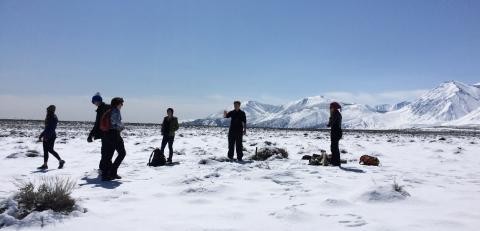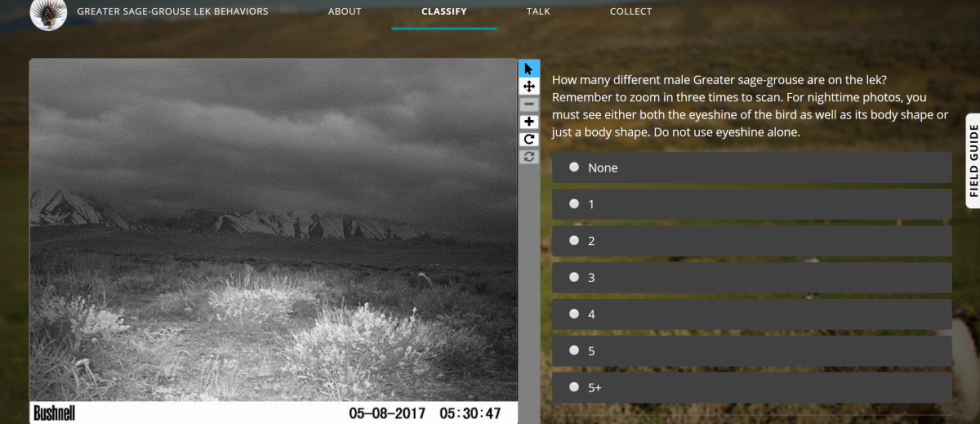Zooniverse as a Research Tool
Submitted by Ryan on Mon, 09/18/2017 – 11:30am
Scientist Perspective
Eric Tymstra is a PhD student at UC Davis, who collaborated with our team on the sage grouse case study. In this Scientist Perspective, Eric reflects on the experience of working with high schoolers on a project with components both in the field and online.
As an ecologist, it is not common that I get an opportunity to share unfiltered love for my study species and science with members of the general public. Greater sage-grouse (Centrocercus urophasianus) are a well-known species often wrought with controversy. Despite their fame, it is rare to find members of the public who are genuinely excited about these birds. In early spring 2017, I had the privilege of starting a youth-focused citizen science project in California’s Eastern Sierra. As someone who found their passion for wildlife and conservation at a young age because of people who encourage me to follow my interests, being able to facilitate the pursuit of interest in high school students was an amazing opportunity. In order for students to have easy access to project resources, we developed an online platform through Zooniverse. This site is an exciting and fast-growing phenomenon that allows researchers to disseminate their science and its applications widely by involving people around the world. Launching a sage-grouse focused Zooniverse project while working with young people provided an opportunity for me to share a passion for this species and the potential for exciting research on a broad scale.
Zooniverse is an online crowd-sourcing platform that allows scientists to upload data in the form of photos in order for classification by those who visit the site. The sage-grouse project is a bit different in that it asks users to participate in a project that aims to classify both animal presence and behavior captured on trail cameras. The project requires users to first identify the birds on the lek (the area in which males display and compete for females who visit the lek) and then classify the behavior (displaying, mating, male-male aggression, foraging).
In setting up the project, the Zooniverse platform was easy to
navigate and allows researchers to instruct online users in how
to interpret and classify data (photos). Zooniverse’s format also
“gamefies” the process of classifying camera-trap photos.
Classifying thousands of photos of sagebrush with occasional
birds (birds do not spend the entire day displaying) can be
tedious work and involves a lot of photos without any birds.
However, Zooniverse tracks user progress and provides scores to
individuals based on the number of projects participated in and
number of photos classified. To me, this means that users do not
get burnt out from hours of working on one project and are able
to fully appreciate the breadth of scientific research that they
can actively participate in and contribute to. Zooniverse also
provides researchers to share with users the impacts of the
research that they are assisting with.
Results from this project will be used to inform conservation managers in the area. Understanding when and how the birds are using the lek is crucial in deciding where to allocate conservation efforts. Additionally, this information can be used as a “jumping off” point to answer theoretical behavioral questions. On Zooniverse, researchers can develop a site that not only crowd-sources data collection, but also informs participants of the purpose of the project and how data will be used. The sage-grouse project site will link to local working group websites, information on collaborating governmental agencies (Bureau of Land Management), and current animal behavior and conservation behavior research.
Promoting active participation of volunteers is essential in a citizen science project, especially one that coincides with a youth-focused citizen science project. In this case, it was difficult to promote active participation. Without being present and interacting with students regularly, it was a challenge to encourage students to continually work through photo datasets.
However, it is clear that any project can benefit greatly from community-driven science through an online platform, especially when it comes to conservation science. Sage-grouse in the Eastern Sierra are part of the Bi-State population, which is genetically distinct from all other sage-grouse populations. However, similarly to other populations of sage-grouse, this bird is facing many conservation threats including habitat loss and introduced species (ravens) and the species has been considered for listing under the Endangered Species Act. Recent criticisms of the Endangered Species Act have included calls for the legislation to empower a diversity of stakeholders and to include local, adaptive and ecologically based approaches to management. Management literature has also called for social-ecological systems approaches to conservation that take the relationships between people and biological systems into account. Conservation effort for the BiState population have included stakeholders from the Bureau of Land Management, Nevada Department of Wildlife, California Department of Wildlife, the US Forest Service, Natural Resources Conservation Service, US Geological Survey, Mono County as well as private, state, and tribal landowners, making the BiState population a poster child for cooperative conservation efforts that consider social ecological systems.
Conservation efforts are undoubtedly strengthened by a diversity of stakeholders; this is especially true of sage-grouse. Though the conservation goals for this population are highly actionable, it was surprising to find that many of the local students had never seen a sage-grouse much less been educated on threats to the species. It was this disconnection that made a community science project exciting. As an ecological researcher, it is important to me that my work influences the way that people think about and interact with their local environment. This project allows me to guide that influence both on the ground and with a wider online audience. It is my hope that, as this project grows, those who participate both in person and online will gain an appreciation for behavioral ecology research and its applications both in the context of the sagebrush steppe and systems beyond.










